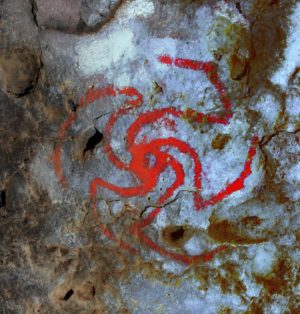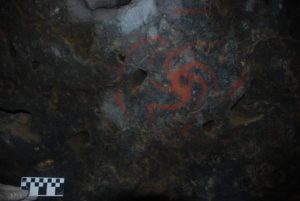
PROCEEDINGS OF THE NATIONAL ACADEMY OF SCIENCES—A study* finds evidence suggesting that a hallucinogenic plant was consumed at a rock art site and that the art is likely a representation of the plant. A long-established hypothesis holds that creators of rock art may have been in altered states of consciousness, but conclusive evidence of consumption of hallucinogens at rock art sites is lacking. David W. Robinson et al. analyzed fibrous bundles called quids, found in the ceiling of Pinwheel Cave in California. Because a pinwheel-like design painted on the cave resembles the flower Datura wrightii, which has known hallucinogenic properties and was used by Native Californians to induce trance states, the authors explored whether the quids might have contained Datura. Three-dimensional analysis of the quids suggested that they had been chewed, potentially inside the cave and under the paintings. Further analysis revealed the presence of the hallucinogenic compounds scopolamine and atropine in the quids, and scanning electron microscopy confirmed that the fibers in the quids came from Datura. The authors report that the paintings in the cave were likely not representations of the visual phenomena induced by Datura but, rather, representations of the plant itself that may have served to convey knowledge about the plant in preparation for a communal experience. According to the authors, the results both confirm the use of hallucinogens in rock art and challenge the previous model of the hallucinogens’ influence on the form of rock art.
____________________________

Digital image of Pinwheel painting, processed with an image enhancing technique called D-Stretch. Devlin Gandy
____________________________

Photograph of pinwheel painting with hallucinogenic Datura wrightii quid in crevice seen on the lower left next to the 10-cm scale. David Wayne Robinson
____________________________
Article Source: PNAS news release
*”Datura quids at Pinwheel Cave, California, provide unambiguous confirmation of the ingestion of hallucinogens at a rock art site ,” by David W. Robinson et al.
____________________________
Advertisement





